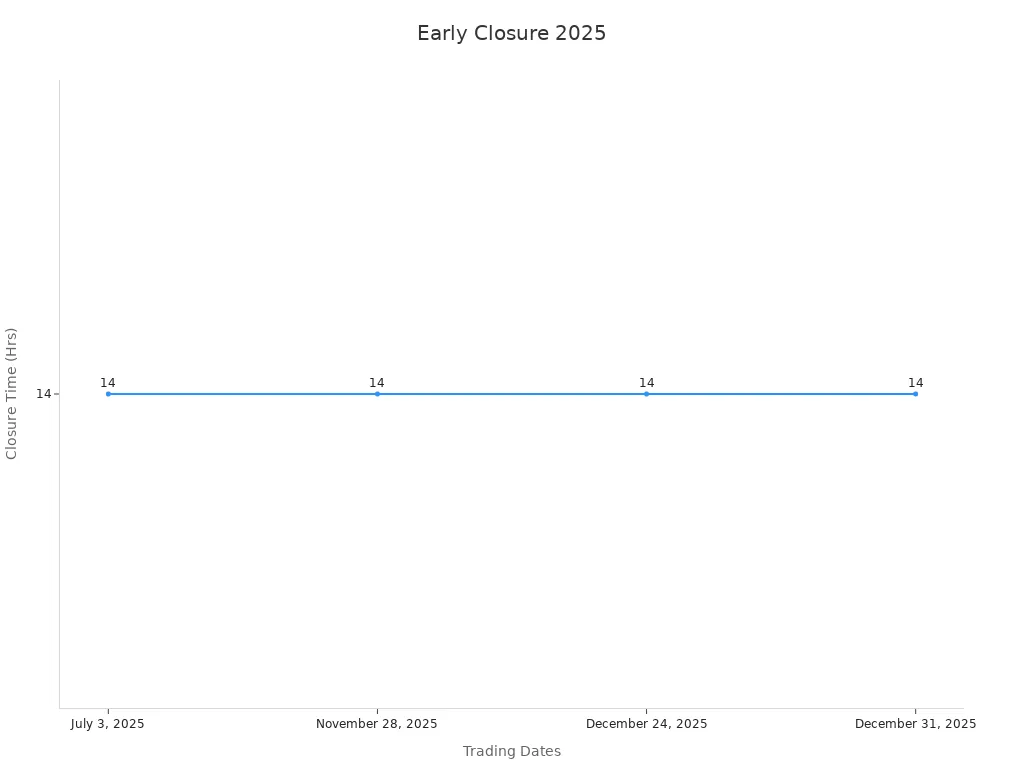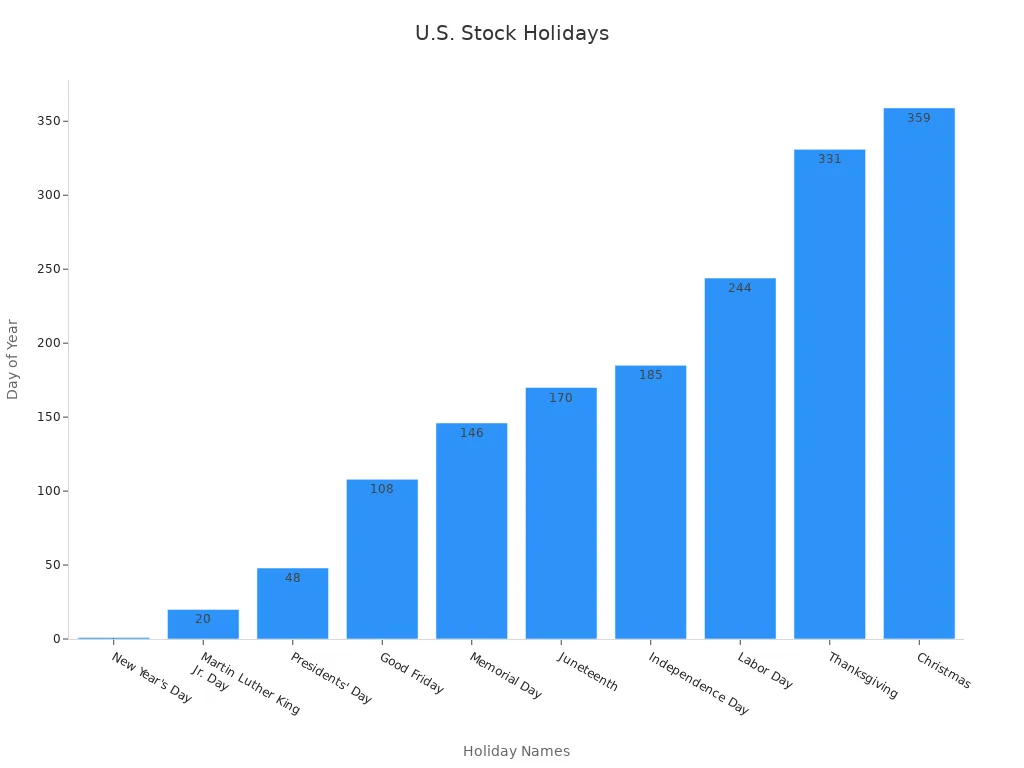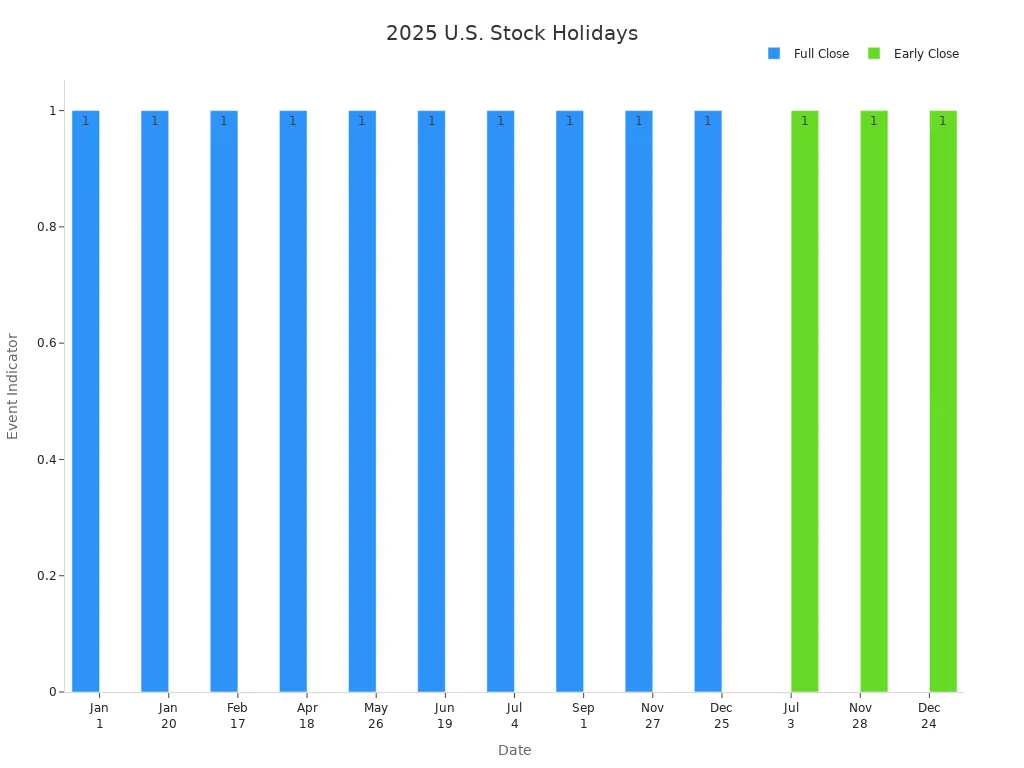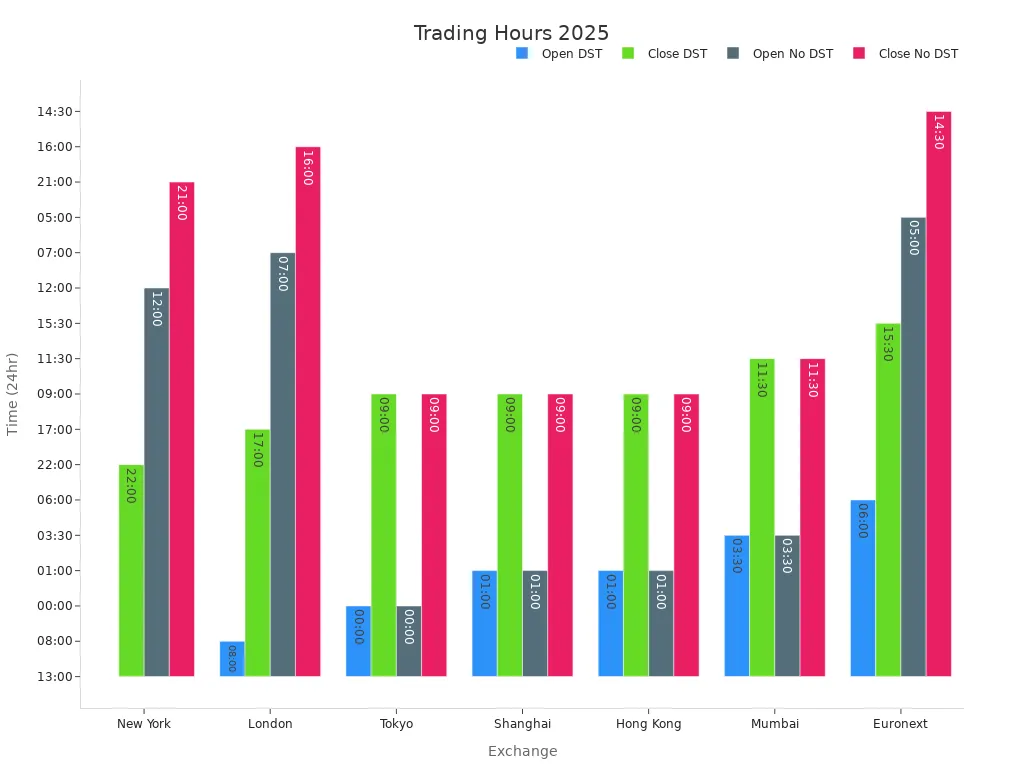- EasyCard
- Trade
- Help
- Announcement
- Academy
- SWIFT Code
- Iban Number
- Referral
- Customer Service
- Blog
- Creator
Complete Guide to Stock Market Trading Hours and Holidays in 2025

Image Source: pexels
You need to know the exact schedule for the stock market 2025 to plan your trades well. The U.S. stock market 2025 regular hours run from 9:30 a.m. to 4:00 p.m. Eastern Time. On June 17, 2025, nearly 8.8 billion shares traded during these hours, showing how active the market stays. Pre-market and after-hours trading now make up over 11% of all activity, with more than 1.7 billion shares traded daily outside regular hours. Official stock market 2025 holidays, including Juneteenth, can affect your investment timing. Many studies show that trading before holidays often brings higher returns, while days after holidays may see lower returns. You can use this guide to stay on top of every important date and market hour for the year.
Key Takeaways
- The U.S. stock market regular hours run from 9:30 a.m. to 4:00 p.m. Eastern Time on weekdays, with most trading activity happening at the start and end of the day.
- You can trade stocks during pre-market (4:00 a.m. to 9:30 a.m.) and after-hours (4:00 p.m. to 8:00 p.m.) sessions, but expect lower volume and higher risk due to less liquidity.
- The stock market closes on major U.S. holidays in 2025, including Juneteenth, and has early closures before or after some holidays, so plan your trades accordingly.
- International stock markets have different trading hours and holidays, so check local times and calendars to avoid missed opportunities or surprises.
- Early closures and holiday effects can increase market volatility and change trading volume, so use this knowledge to adjust your trading strategy and manage risk.
Stock Market Trading Hours

Image Source: unsplash
Regular Hours
You need to know when the stock market open and close to plan your trades. The regular trading hours for the NYSE and Nasdaq in 2025 run from 9:30 a.m. to 4:00 p.m. Eastern Time. These hours stay the same every weekday, except on holidays or special early closure days. Most trading happens during these hours. You see the highest trading activity at the start and end of the day. The market open and close work like auctions, matching buy and sell orders at a single price. This process helps set fair prices for stocks.
Here is a table that shows the regular trading hours for the NYSE and Nasdaq:
| Stock Exchange | Regular Trading Hours | Total Hours per Trading Day |
|---|---|---|
| New York Stock Exchange (NYSE) / Nasdaq | 9:30 AM - 4:00 PM Eastern Time | 6.5 hours |
You notice that trading activity changes during the day. The morning and late afternoon see more trades and higher volatility. Around lunchtime, trading slows down. On some days, like when index funds rebalance or options expire, you see even more trading near the close. The regular trading hours give you the best liquidity and the tightest bid-ask spreads.
Tip: Always check the official NYSE and Nasdaq calendars for any updates to the regular trading hours.
Pre-Market and After-Hours
You can trade stocks before the market officially opens and after it closes. These sessions are called pre-market and after-hours trading. The pre-market session for NYSE and Nasdaq starts as early as 4:00 a.m. and runs until 9:30 a.m. Eastern Time. After-hours trading begins at 4:00 p.m. and ends at 8:00 p.m. Eastern Time. Some brokers let you access pre-market trading hours starting at 4:00 a.m., but most activity picks up after 8:00 a.m.
| Trading Session | NYSE & Nasdaq Typical Hours (ET) | Notes |
|---|---|---|
| Pre-Market | 4:00 a.m. – 9:30 a.m. | Some brokers allow access starting at 4 a.m., but most activity starts at 8 a.m. |
| Regular Trading | 9:30 a.m. – 4:00 p.m. | Standard market hours |
| After-Hours | 4:00 p.m. – 8:00 p.m. | Volume thins after 6:30 p.m.; trading via electronic networks |
Pre-market and after-hours trading let you react to news and events outside regular hours. You might see lighter trading volumes in these sessions, but they still give you clues about market sentiment. Sometimes, after-hours trading can show big price moves, especially after company earnings reports. However, you should know that these sessions often have less liquidity and wider spreads. This can make trading riskier. In 2025, more investors join these sessions, and volumes keep growing, but the market can be more volatile.
Early Closures
On certain days, the NYSE and Nasdaq close early. You need to watch for these dates because trading ends at 2:00 p.m. Eastern Time instead of the usual 4:00 p.m. Early closures often happen before or after major holidays. In 2025, the stock market closes early on July 3 (before Independence Day), November 28 (after Thanksgiving), and December 24 (before Christmas). Sometimes, December 31 (before New Year’s Day) also sees an early close.
| Date | Event | Early Closure Time (Eastern Time) |
|---|---|---|
| July 3, 2025 | Day before Independence Day | 2:00 p.m. |
| November 28, 2025 | Day after Thanksgiving | 2:00 p.m. |
| December 24, 2025 | Day before Christmas | 2:00 p.m. |
| December 31, 2025 | Day before New Year’s Day | 2:00 p.m. |

You should plan your trades around these early closure days. Trading volumes can drop, and price swings may be larger. The NYSE and Nasdaq both follow these early closure times. Always check the official schedule so you do not miss important trading opportunities.
Note: Early closure days can affect your trading strategy. Make sure you know when the stock market open and close on these special dates.
U.S. Stock Market Holidays
Holiday List
You need to know the official u.s. stock market holidays if you want to plan your trades in 2025. Both the nyse and nasdaq follow the same holiday schedule. These holidays mark the days when the stock market is closed, so you cannot buy or sell stocks during these times. Here is a list of the main holidays for 2025:
- New Year’s Day
- Martin Luther King Jr. Day
- Presidents’ Day (Washington’s Birthday)
- Good Friday
- Memorial Day
- Juneteenth National Independence Day
- Independence Day
- Labor Day
- Thanksgiving Day
- Christmas Day
The nyse and nasdaq also have early closures on certain days. You will see the market close early before Independence Day, after Thanksgiving, and on Christmas Eve. These early closures help traders and staff prepare for the holidays.
| Holiday Name | 2025 Date | Early Closure Date (if any) |
|---|---|---|
| New Year’s Day | Wednesday, Jan 1 | |
| Martin Luther King Jr. Day | Monday, Jan 20 | |
| Presidents’ Day | Monday, Feb 17 | |
| Good Friday | Friday, Apr 18 | |
| Memorial Day | Monday, May 26 | |
| Juneteenth | Thursday, Jun 19 | |
| Independence Day | Friday, Jul 4 | Thursday, Jul 3 |
| Labor Day | Monday, Sep 1 | |
| Thanksgiving Day | Thursday, Nov 27 | Friday, Nov 28 |
| Christmas Day | Thursday, Dec 25 | Wednesday, Dec 24 |
Note: The nyse and nasdaq always announce these dates in advance. You should check their official calendars each year.

Holiday Dates
You must remember the exact dates for each holiday. The stock market open and close times change on these days. The table below shows the 2025 holiday schedule for the nyse and nasdaq. This helps you avoid surprises when the market is closed.
| Holiday Name | 2025 Date | Observed Date (if different) | Notes and Planning Advice |
|---|---|---|---|
| New Year’s Day | Wednesday, Jan 1 | N/A | Start of the year; plan vacation days around Jan 2-3 if you want a longer break. |
| Martin Luther King Jr. Day | Monday, Jan 20 | N/A | Federal holiday; not all private companies close. |
| Presidents’ Day | Monday, Feb 17 | N/A | Also called Washington’s Birthday. |
| Good Friday | Friday, Apr 18 | N/A | Not a federal holiday, but the stock market is closed. |
| Memorial Day | Monday, May 26 | N/A | Start of summer for many families. |
| Juneteenth | Thursday, Jun 19 | N/A | Newest federal holiday; market is closed. |
| Independence Day | Friday, Jul 4 | N/A | Early closure on July 3. |
| Labor Day | Monday, Sep 1 | N/A | End of summer; many people travel. |
| Thanksgiving Day | Thursday, Nov 27 | N/A | Major family holiday; plan travel to avoid crowds. |
| Day After Thanksgiving | Friday, Nov 28 | N/A | Early closure; some companies give this day off. |
| Christmas Day | Thursday, Dec 25 | N/A | Early closure on Dec 24; plan vacation to extend the holiday. |

Tip: If a holiday falls on a weekend, the market usually closes on the nearest weekday. Always check the nyse and nasdaq calendars for updates.
Holiday Impact
U.s. stock market holidays affect trading in many ways. When the market is closed, you cannot place trades or adjust your portfolio. You may see changes in stock prices before and after holidays. Many investors notice that prices often rise before a holiday. This is called the pre-holiday rally effect. After the holiday, prices sometimes dip as trading resumes and investors react to new information.
You will also see changes in trading volume. The day before a holiday, trading volume often increases as investors adjust their positions. On the day after a holiday, volume can spike again as news and events from the break get priced in. During holidays, you cannot trade U.S. stocks, but you can watch international markets like ADRs and GDRs for clues about global trends.
- Trading volume drops sharply on days right before and after holidays. This shows that many investors pay less attention during these times.
- Stocks rarely show extreme price moves around holidays. When they do, prices often drift in the days after, as investors catch up.
- These effects do not happen around regular weekends. They are unique to stock market holidays and early closures.
- Behavioral finance research shows that mood, optimism, and social events can influence investor decisions around holidays.
- Many traders use special strategies, like monitoring volume or using stop-loss orders, to manage risk during these periods.
You should always plan your trades around the stock market open and close times for holidays. Early closures on July 3, November 28, and December 24 mean you have less time to trade. The nyse and nasdaq both follow these early closure rules. If you miss these times, you may have to wait until the next trading day.
Remember: U.s. stock market holidays and early closures can change your trading strategy. Always check the official schedule so you know when the market is closed.
International Stock Market Hours
You need to know the stock market trading hours for exchanges around the world. Each region has its own schedule. These hours can affect your trading strategy, especially if you invest in global stocks.
Americas
In the Americas, you find some of the largest stock markets. The New York Stock Exchange (NYSE) and Nasdaq in the United States open from 9:30 a.m. to 4:00 p.m. Eastern Time. In canada, the Toronto Stock Exchange (TSX) follows a similar schedule. You see the TSX open from 9:30 a.m. to 4:00 p.m. Eastern Time. Many investors in canada also trade on the TSX Venture Exchange, which uses the same hours. If you want to check trading hours in canada, always look at the official TSX calendar.
| Exchange | Country | Local Open | Local Close | UTC Open | UTC Close |
|---|---|---|---|---|---|
| NYSE/Nasdaq | USA | 9:30 AM | 4:00 PM | 14:30 | 21:00 |
| Toronto Stock Exchange | Canada | 9:30 AM | 4:00 PM | 14:30 | 21:00 |
| B3 (São Paulo) | Brazil | 10:00 AM | 5:00 PM | 13:00 | 20:00 |
| Mexican Stock Exchange | Mexico | 8:30 AM | 3:00 PM | 14:30 | 20:00 |
Tip: Trading hours in canada match U.S. hours, so you can plan trades across both markets easily.
Europe
European stock markets open earlier than those in the Americas. The London Stock Exchange (LSE) opens at 8:00 a.m. and closes at 4:30 p.m. local time. Euronext, which covers France, the Netherlands, Belgium, and Portugal, opens at 9:00 a.m. and closes at 5:30 p.m. local time. You see most trading in Europe happen during these hours. The World Federation of Exchanges confirms these times in its 2025 factsheets.
| Exchange | Country/Region | Local Open | Local Close | UTC Open | UTC Close |
|---|---|---|---|---|---|
| London (LSE) | UK | 8:00 AM | 4:30 PM | 08:00 | 16:30 |
| Euronext | Europe | 9:00 AM | 5:30 PM | 08:00 | 16:30 |
| Deutsche Börse | Germany | 9:00 AM | 5:30 PM | 08:00 | 16:30 |
| SIX Swiss | Switzerland | 9:00 AM | 5:30 PM | 08:00 | 16:30 |
Asia
Asia has some of the busiest stock markets. The Tokyo Stock Exchange opens at 9:00 a.m. and closes at 3:00 p.m. local time, with a lunch break from 11:30 a.m. to 12:30 p.m. The Shanghai Stock Exchange and Hong Kong Stock Exchange both open at 9:30 a.m. and close at 3:00 p.m., also with a lunch break. You need to check local times because trading hours can change during holidays.
| Exchange | Country/Region | Local Open | Local Close | UTC Open | UTC Close |
|---|---|---|---|---|---|
| Tokyo | Japan | 9:00 AM | 3:00 PM | 00:00 | 06:00 |
| Shanghai | China | 9:30 AM | 3:00 PM | 01:30 | 07:00 |
| Hong Kong | Hong Kong | 9:30 AM | 4:00 PM | 01:30 | 08:00 |
| Mumbai (NSE) | India | 9:15 AM | 3:30 PM | 03:45 | 10:00 |
Africa
Africa’s largest stock market is the Johannesburg Stock Exchange (JSE). The JSE opens at 9:00 a.m. and closes at 5:00 p.m. local time. You see most trading in South Africa during these hours. Other African exchanges may have different schedules, so always check their websites.
| Exchange | Country | Local Open | Local Close | UTC Open | UTC Close |
|---|---|---|---|---|---|
| Johannesburg (JSE) | South Africa | 9:00 AM | 5:00 PM | 07:00 | 15:00 |
| Nigerian Exchange | Nigeria | 9:30 AM | 2:30 PM | 08:30 | 13:30 |
Oceania
In Oceania, the Australian Securities Exchange (ASX) is the main market. The ASX opens at 10:00 a.m. and closes at 4:00 p.m. local time. The New Zealand Exchange (NZX) opens at 10:00 a.m. and closes at 4:45 p.m. local time. You can trade stocks in these markets during these hours.
| Exchange | Country | Local Open | Local Close | UTC Open | UTC Close |
|---|---|---|---|---|---|
| ASX | Australia | 10:00 AM | 4:00 PM | 00:00 | 06:00 |
| NZX | New Zealand | 10:00 AM | 4:45 PM | 22:00 | 02:45 |

You should always check for daylight saving time changes. These can shift trading hours by one hour in some regions. Knowing the right hours helps you plan your trades and manage risk in the global stock market.
Stock Market Holidays Worldwide

Image Source: pexels
Major Global Holidays
You need to know the main stock market holidays if you trade in different countries. Most major exchanges close for New Year’s Day on January 1. In the United States, the NYSE and Nasdaq also close for Martin Luther King Jr. Day, Presidents’ Day, Good Friday, Memorial Day, Juneteenth, Independence Day, Labor Day, Thanksgiving Day, and Christmas Day. Other countries have their own important holidays. For example, the London Stock Exchange closes for Good Friday and Christmas. The Tokyo Stock Exchange closes for New Year’s, Golden Week, and national holidays in Japan. The Shanghai Stock Exchange closes for Chinese New Year and National Day.
Here is a table that shows some key 2025 stock market holidays for major exchanges:
| Date | Holiday/Event | Markets Closed or Early Closure |
|---|---|---|
| Jan 1, 2025 | New Year’s Day | NYSE, Nasdaq, London, Tokyo, Shanghai |
| Feb 17, 2025 | Presidents’ Day | NYSE, Nasdaq |
| Apr 18, 2025 | Good Friday | NYSE, Nasdaq, London, Euronext |
| Feb 3-7, 2025 | Chinese New Year | Shanghai, Hong Kong |
| May 1, 2025 | Labor Day | Euronext, Deutsche Börse, Shanghai |
| Jul 4, 2025 | Independence Day | NYSE, Nasdaq |
| Oct 1-7, 2025 | National Day (China) | Shanghai, Hong Kong |
| Dec 25, 2025 | Christmas Day | NYSE, Nasdaq, London, Euronext |
Note: Each stock market sets its own holiday calendar. Always check the official exchange website before you trade.
Regional Differences
Stock market holidays look different in each region. In the United States, you see early closures before Independence Day, after Thanksgiving, and on Christmas Eve. In Europe, most exchanges close for Good Friday and Christmas, but some also close for Easter Monday. Asian markets, like Tokyo and Shanghai, close for local holidays such as Golden Week or Chinese New Year. In Australia, the ASX closes for Australia Day and Christmas. South Africa’s JSE closes for public holidays like Human Rights Day and Freedom Day.
You should pay attention to these differences. When one market closes for holidays, others may stay open. This can affect prices and trading volume. If you trade international stocks, you need to plan for these stock market holidays. Missing a holiday can lead to missed trades or unexpected price changes.
- Always check the holiday schedule for each exchange.
- Watch for early closures, especially in the U.S. stock market.
- Remember that holidays can change each year.
Tip: Use a global calendar to track all major stock market holidays. This helps you avoid surprises and plan your trades better.
Special Cases
Early Closures
You will notice that the stock market sometimes closes earlier than usual. These early closures often happen before or after major holidays. For example, in 2025, the U.S. stock market will close at 1:00 p.m. Eastern Time on July 3, November 28, and December 24. Early closures help manage trading activity and allow staff to prepare for holidays. When the market closes early, you see lower trading volumes and sometimes higher price swings as traders rush to finish their business. Delayed settlements can also occur, especially if you trade across different countries. Early closures in the U.S. and Canada can even influence global trading patterns.
- Early closures reduce trading hours and liquidity.
- Volatility may increase as traders adjust positions quickly.
- International trades may face delayed settlements.
Tip: Always check the official calendar for early closure dates so you do not miss important trading opportunities.
Lunch Breaks
Some stock markets, especially in Asia and Europe, have scheduled lunch breaks during the trading day. For example, the Tokyo Stock Exchange pauses from 11:30 a.m. to 12:30 p.m. local time. The Shanghai Stock Exchange also has a lunch break from 11:30 a.m. to 1:00 p.m. These breaks split the trading hours into morning and afternoon sessions. During lunch breaks, you cannot place trades, and prices stay the same until the market reopens. European markets like the London Stock Exchange do not have lunch breaks, so trading continues without pause.
| Exchange | Morning Session | Lunch Break | Afternoon Session |
|---|---|---|---|
| Tokyo (Japan) | 9:00–11:30 AM | 11:30–12:30 PM | 12:30–3:00 PM |
| Shanghai (China) | 9:30–11:30 AM | 11:30–1:00 PM | 1:00–3:00 PM |
| London (UK) | 8:00–4:30 PM | None | None |
Lunch breaks can affect your trading strategy. You may see price gaps when the market reopens after lunch, especially if news comes out during the break.
Time Zones
Time zones play a big role in the global stock market. When you trade stocks from different countries, you must pay attention to the local trading hours. Time zone differences can cause valuation mismatches. For example, if you and your counterparty use exchange rates from different times of day, you may see differences in trade values. This can lead to disputes or delays in settling trades. Some investors in later time zones trade less aggressively because they have less time to react to news. Daylight saving time can also change trading behavior, making some investors more active.
- Always check the local hours for each stock market you want to trade.
- Use tools or calendars that show trading hours in your own time zone.
- Be aware that daylight saving time can shift market hours by one hour in some regions.
Note: Many financial centers use daily checks and third-party services to match FX rates and trading times, helping reduce errors caused by time zone differences.
You now have a clear overview of stock market 2025 trading hours and holidays. The table below confirms the regular hours, pre-market, after-hours, and major holidays for 2025, based on Nasdaq’s official schedule:
| Aspect | Details |
|---|---|
| Regular Trading Hours | 9:30 AM to 4:00 PM Eastern Time, Monday through Friday |
| Pre-Market Hours | 4:00 AM to 9:30 AM Eastern Time |
| After-Hours Trading | 4:00 PM to 8:00 PM Eastern Time |
| Major U.S. Market Holidays in 2025 | New Year’s Day, Martin Luther King Day, Presidents’ Day, Memorial Day, Juneteenth, Independence Day, Labor Day, Thanksgiving Day, Christmas Day |
| Total Trading Days | Approximately 252 days in 2025, accounting for weekends and holidays |
Always check with exchanges for last-minute changes. Bookmark this guide to stay prepared for every stock market 2025 schedule.
FAQ
What are the regular trading hours for the U.S. stock market in 2025?
You can trade on the NYSE and Nasdaq from 9:30 a.m. to 4:00 p.m. Eastern Time, Monday through Friday. These hours do not change except for holidays or early closures.
Can you trade stocks outside regular hours?
Yes, you can trade during pre-market (4:00 a.m. to 9:30 a.m. ET) and after-hours (4:00 p.m. to 8:00 p.m. ET) sessions. These periods often have lower trading volumes and higher price swings.
How do U.S. stock market holidays affect trading?
On holidays, you cannot buy or sell stocks. Trading stops completely. You should check the official holiday calendar each year to avoid missing important dates.
Do all global stock markets close at the same time?
No, each country sets its own trading hours and holidays. For example, the Tokyo Stock Exchange in Japan opens when the U.S. market is closed. Always check local times before trading.
What happens if a holiday falls on a weekend?
If a holiday lands on a Saturday or Sunday, the market usually closes on the nearest weekday. You should always confirm with the official NYSE or Nasdaq schedule for exact dates.
2025 market holidays and early closures may disrupt trading, with pre-market and after-hours low liquidity and global time zone differences posing challenges. To address this, register a BiyaPay account in just 1 minute to access U.S. and Hong Kong stock investments, navigating these constraints seamlessly. BiyaPay offers remittance fees as low as 0.5%, covering 190+ countries with swift transfers, and supports fee-free conversion of 200+ digital currencies (like USDT) to USD, HKD, and JPY, enhancing global fund management and trading efficiency.
Seize opportunities despite market limits! Join BiyaPay.
*This article is provided for general information purposes and does not constitute legal, tax or other professional advice from BiyaPay or its subsidiaries and its affiliates, and it is not intended as a substitute for obtaining advice from a financial advisor or any other professional.
We make no representations, warranties or warranties, express or implied, as to the accuracy, completeness or timeliness of the contents of this publication.




Contact Us
Company and Team
BiyaPay Products
Customer Services
is a broker-dealer registered with the U.S. Securities and Exchange Commission (SEC) (No.: 802-127417), member of the Financial Industry Regulatory Authority (FINRA) (CRD: 325027), member of the Securities Investor Protection Corporation (SIPC), and regulated by FINRA and SEC.
registered with the US Financial Crimes Enforcement Network (FinCEN), as a Money Services Business (MSB), registration number: 31000218637349, and regulated by FinCEN.
registered as Financial Service Provider (FSP number: FSP1007221) in New Zealand, and is a member of the Financial Dispute Resolution Scheme, a New Zealand independent dispute resolution service provider.




















